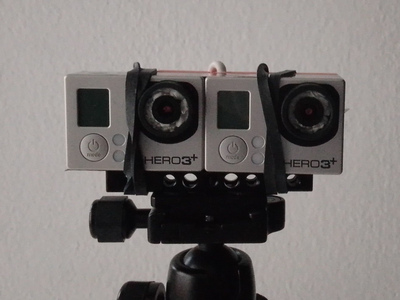gopro stereoscopic 3d rig
gopro once released a stereo system with synchronization cable for the gopro hero3+ black edition (2013). it controls both cameras from one camera and synchronizes all settings, including exposure and white balance, and the recording of frames. the resulting files are also automatically named with a corresponding 3D_L or 3D_R prefix. the file numbering that follows after the prefix is not synchronized, though. additionally, timecodes are added to video file metadata.
the supported recording formats per camera, that i am most interested in, are 2160p15, 1080p60, and 720p120 for videos, and 4000x3000 for photos. this allows for a combined resolution of 3840x1080 for videos, or even 7680x2160 with 15 frames per second, and 8000x3000 for photos. also notable is the protune option, which allows the customization of more recording settings like color profiles, iso, and shutter speed. the super and 17:9 formats are wide formats.
the cameras each have a dimension of 58.4×38.1x20.3mm. the interaxial distance is variable from a minimum of about 29mm to about 90mm, limited only by the length of the sync cable.
gopro did not continue stereoscopy support with later models.
pros
- variable interaxial distance
- the cameras are versatile
- easy to use
- lightweight
- inexpensive
cons
- the standard lenses are wide and results may not look desirable. replacing the lenses and getting them to perform the same and being equally well focused is tricky (it easily damages the case, fixed manual focus necessary using possibly loose screw-in of the lenses). this is the reason why i gave up on this setup
- the system does not have the sleek looks of a fully integrated solution
- older technology with a maximum of 2160p15
- the sync plugs have to be removed for changing the batteries. this wears down the connectors and cable
- handling two separate sd cards, and copying files from two separate sd cards
- the required parts are not manufactured anymore and might be difficult to acquire
- customization is required, except when using the default ~29mm interaxial distance with the waterproof box
- merging of files, which are differentiated by camera but not numbered pairwise, into the desired target format
- small lenses/sensors
required parts
the minimum required parts are:
- gopro dual hero system for the sync cable
gopro hero3+ black edition
- identifiable by a black 3 followed by a plus on the front right of the camera. not to be confused with the incompatible silver edition that has a gray 3
- the 3+ black edition has a higher resolution sensor and more features than the silver or non-plus versions, and is the only model supported by the dual hero system
- micro sd cards
firmware updates
the cameras should be updated to the latest firmware. i bought the cameras used and faced some issues:
- i installed the firmware by copying the files provided by gopro onto a micro sd card, as described on their website. however, it was only detected when i copied it to an older micro sd card
- connecting to the camera via the app was not possible. an old wifi password was set, which could be changed with the settings text file of the wi-fi update. however, even after changing the password and entering it correctly, no connection could be established
modifying the sync cable
depending on the desired positioning of the cameras, the dual hero sync cable might have to be modified.
to have the cameras attach directly next to each other, the cable has to be modified to come out of the box at the bottom instead of the side. to achieve this, i opened the orange (L) dual hero sync box with a small torx-like screwdriver, cut off the corner rubber with an exacto knife to make it fit better, and re-positioned the cable before i closed the box again. for the time being, i used a putty-like adhesive to fix it and reduce stress on the fragile internal cable connections.
merging the files
the software once provided by gopro for post-processing might not be available anymore. regardless, it would probably not work on my linux system. therefore, i wrote a shell script that uses a few common tools to create combined side-by-side versions of photos and videos. one image-side is rotated, because the dual hero system has one camera upside down in its standard configuration and automatically rotates the image on creation.
links
- an example build with external monitor by scstudios8
- with even more customization, a gopro hero 4 rig is possible. example
additional parts
in the current version of my setup, i used these additional parts:
- two so-called cheese plates. 90x50mm (i would have preferred 70x30) and 90x15mm
- adhesive tape to connect the cameras
- rubber bands to attach the cameras to the bottom plate
- extra screws and attachments to add an extra microphone above the center of the cameras
(not yet received) replacement lenses with a focal length of 8.25mm, which corresponds to a 47mm focal distance on a 35mm sensor, the closest to 50mm i could find
it has yet to be seen if the lenses will have an ir cut filter
the default lenses add fisheye distortion
status
the status of my current build is as follows:
- video test successful
- photo test successful
- to be tested: mounting on tripod, attaching a separate microphone and audio recorder, replacing the lenses
so far, it works nicely as a handheld. it has yet to be seen if rubber bands will be a good solution for attaching the cameras to a mounting plate.




